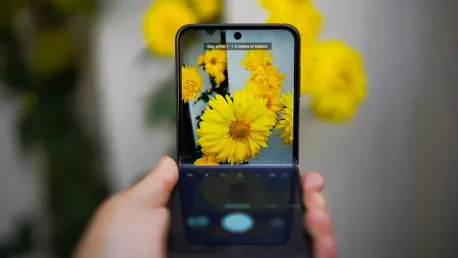Foldable smartphones have made a significant transition from being mere technological novelties to gaining considerable traction in the mobile market, although they are still not widespread. Initially introduced by Samsung in 2019 with the Galaxy Z Fold, these innovative devices are no longer just fascinating curiosities. They have opened up a new frontier in mobile technology, offering unique advantages in mobile photography, multitasking, and overall user experience. This analysis delves into the varied strategies and technological advancements that different manufacturers employ to tackle the challenges and leverage the opportunities posed by foldable technology, with a particular focus on camera performance, distinctive usage scenarios, and the comprehensive user experience.
Evolution and Current State of Foldable Smartphones
Foldable smartphones have evolved significantly since their inception, with manufacturers striving to overcome several key challenges. Designing these devices to be thinner, lighter, and equipped with larger, brighter inner screens while also ensuring improved battery life proves to be a complex task, contributing to their high price tags. The introduction of Samsung’s Galaxy Z Fold marked the beginning of this journey, but subsequent models have mostly seen incremental improvements rather than groundbreaking innovations.
Despite these hurdles, foldable smartphones are designed to offer unique use cases that traditional smartphones cannot, particularly in terms of multitasking and user experience. However, these devices still encounter compromises, particularly in camera performance as manufacturers attempt to balance high production costs. The continuous evolution of foldable smartphones exemplifies the industry’s dedication to stretching the limits of what is possible in mobile technology, underscoring its commitment to advancing the functionality and convenience of these innovative devices.
Brand Strategies and Focus Areas
Different manufacturers have adopted distinct strategies and areas of emphasis when developing their foldable smartphones. Samsung and Google, for instance, are heavily investing in the integration of AI features to enhance the user experience by providing more intelligent and intuitive functionalities. This focus on AI allows these devices to offer more than just a flexible screen, ensuring that the user interface is responsive and adaptive to individual needs and usage patterns.
Conversely, brands such as OnePlus, Vivo, Honor, and Xiaomi prioritize camera performance, striving to deliver substantial innovations in imaging that align with their traditional bar slab phones. The ability to capitalize on the larger screen space for effective multitasking is a significant allure of foldable phones. Among these brands, Samsung stands out with its integration of pen input in the Galaxy Z Fold series, which has not yet been widely adopted by competitors. By focusing on their areas of expertise, these manufacturers aim to carve out their niches within the foldable smartphone market, addressing specific consumer needs and preferences.
Recent Developments and Market Performance
The market performance of foldable smartphones varies significantly across different brands, reflecting their investments in innovation and user-focused features. Samsung’s latest model, the Galaxy Z Fold 6, has been met with mixed reviews due to its iterative changes and compromised camera performance. Despite being priced higher than its predecessor, it lacks compelling value additions, which has dampened its reception in the market.
In stark contrast, Chinese competitors like Vivo, Honor, and Xiaomi are pushing the boundaries of foldable smartphone technology. These brands are making significant strides in camera technology, battery life, and overall multitasking capabilities, surpassing established leaders in some aspects. Although these companies have limited market presence in North America, their advancements are setting high standards in other regions. These innovations challenge the dominance of established players and indicate a rapidly changing competitive landscape in the foldable smartphone market.
Google’s Entrant – Pixel 9 Pro Fold
Google’s entry into the foldable smartphone arena with the Pixel 9 Pro Fold signifies a major step toward redefining what a foldable device should feel like and accomplish. While it has faced some criticism for baffling omissions in camera functionality, the Pixel 9 Pro Fold shines with its advanced AI capabilities, especially in photo editing. Google’s focus on AI integration underscores its strategy to differentiate its foldable smartphones from those of competitors, providing a software-driven experience that leverages AI to enhance user interactions and overall device functionality.
The design and functionality of the Pixel 9 Pro Fold emphasize ease of use and a streamlined user experience, although certain design choices have raised questions among consumers. Nevertheless, Google’s innovative approach highlights the potential of foldable smartphones to offer richer, more sophisticated software experiences, paving the way for future developments and innovations in the foldable segment.
Upstarts Bringing Change
Newer entrants in the foldable smartphone market are injecting fresh perspectives and innovations, often reimagining what these devices can offer. The OnePlus Open, for example, has garnered attention for its superior multitasking features, faster recharge times, and extended battery life. However, it lacks wireless charging—an omission that some users find significant, indicating that there is still room for refinement.
Similarly, Motorola’s Razr, which adheres to its iconic flip-open design, has struggled to make a substantial impact in the market. These upstarts are exploring various ways to enhance the functionality and user-friendliness of foldable smartphones through unique features tailored to meet specific user needs. Their efforts signify the dynamic nature of the market, where new ideas and innovations continuously influence the future direction of foldable smartphone technology.
Overarching Trends and Consensus Viewpoints
The foldable smartphone market is evolving with a trend of incremental rather than groundbreaking innovation across various brands. Many manufacturers are focusing on refining the foldable experience rather than introducing radical new features, aiming to perfect existing concepts and improve usability. Consumers are experiencing improvements in camera quality with new foldable models; however, these enhancements often come at increased prices or with the use of older sensor technology, particularly from brands like Samsung.
AI features are increasingly becoming central to the value proposition of foldable smartphones, particularly for brands such as Samsung and Google. The ability to multitask effectively and the potential for enhanced photography are major factors influencing consumer choices. However, the iterative nature of updates and the high prices of some models are making them less appealing to a broader audience, indicating a need for more accessible and innovative solutions to maintain consumer interest and market growth.
Synthesis and Unified Understanding
Foldable smartphones represent a rapidly evolving segment of mobile technology, characterized by diverse challenges that manufacturers address in various ways. Samsung has led this wave of innovation, continuously refining its designs and focusing on AI and multitasking capabilities. In contrast, Chinese manufacturers such as Vivo, Honor, and Xiaomi are delivering groundbreaking innovations, particularly in camera performance and battery life, although their market presence in North America remains limited.
Samsung’s recent models, notably the Galaxy Z Fold 6, have not generated the expected excitement due to repetitive hardware features and underwhelming changes. Google’s Pixel 9 Pro Fold, on the other hand, places a stronger emphasis on AI integration, guiding the foldable smartphone industry toward richer, software-driven experiences despite some functional limitations.
Newer entrants like the OnePlus Open are offering innovative features like faster recharging capabilities and improved multitasking interfaces but still face challenges such as the absence of wireless charging. In regions where Vivo and Honor dominate, these brands continue to push the envelope in camera functionality and overall design, offering compelling alternatives that can cater to content creation and consumption needs.
Conclusion
Foldable smartphones have evolved significantly, transforming from intriguing tech novelties into notable contenders in the mobile market, albeit not yet mainstream. The breakthrough came in 2019 with Samsung’s Galaxy Z Fold, marking the beginning of a new era for these devices. Initially seen as technological curiosities, foldable smartphones now offer compelling advantages in areas such as mobile photography, multitasking, and overall user experience. This comprehensive analysis explores various strategies and technological advancements employed by different manufacturers to address the unique challenges and seize the opportunities presented by foldable technology. Special attention is given to camera performance, distinct usage scenarios, and user experience enhancements.
Each manufacturer brings their own approach to overcoming the hurdles of foldable technology, whether through innovative hinge designs, advanced display engineering, or software optimization tailored for foldable screens. The differences in these strategies not only highlight the creativity and ingenuity within the industry but also pave the way for future advancements. With improved durability and functionality, foldable smartphones are expected to become more prevalent, offering users a versatile and enhanced mobile experience. As the technology matures, we can anticipate even greater innovations and applications that will further integrate foldable devices into everyday use.









